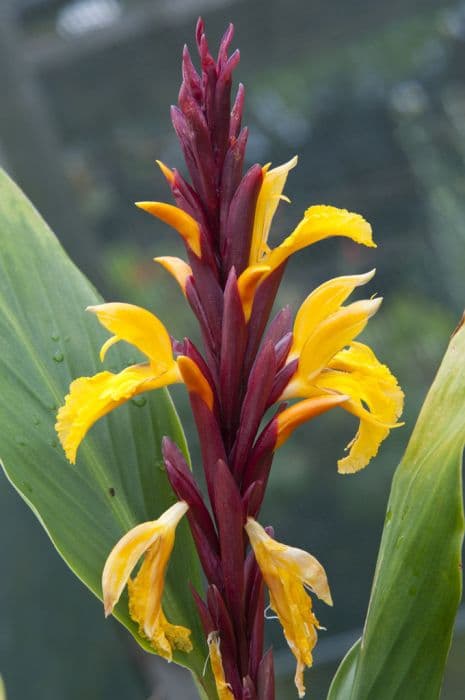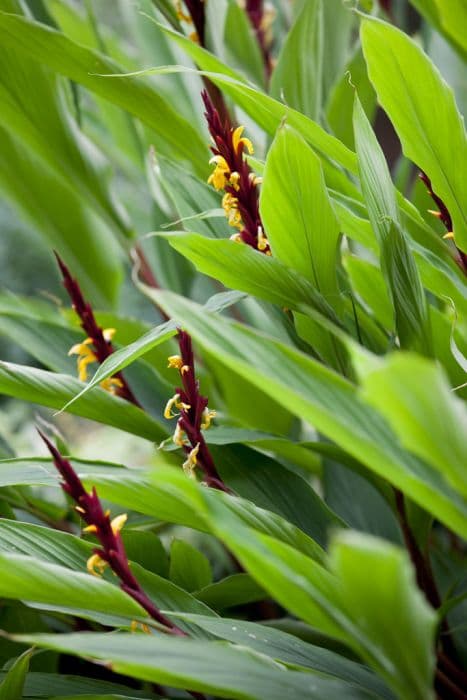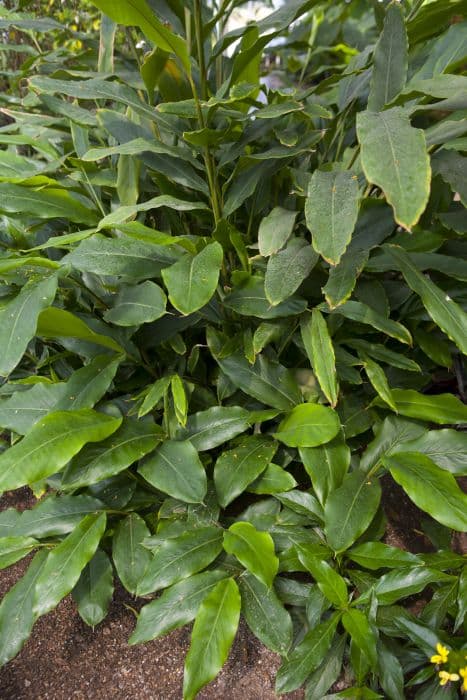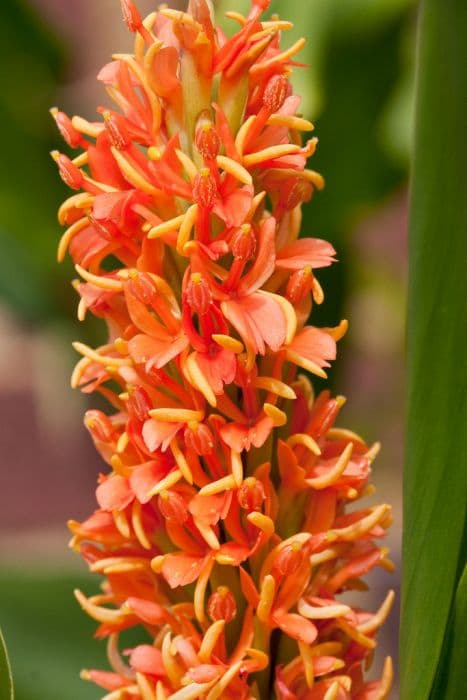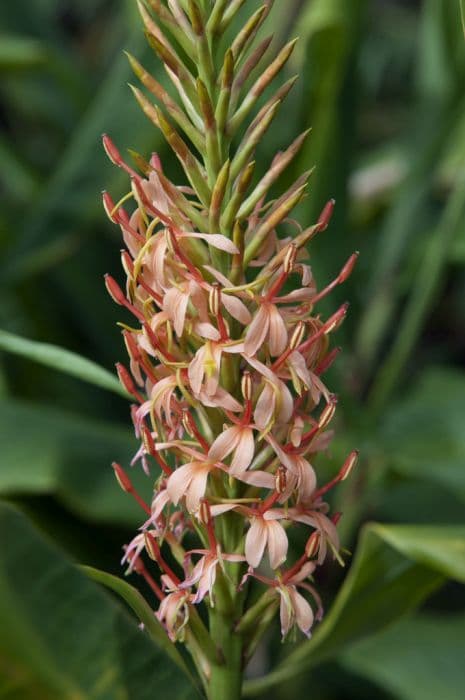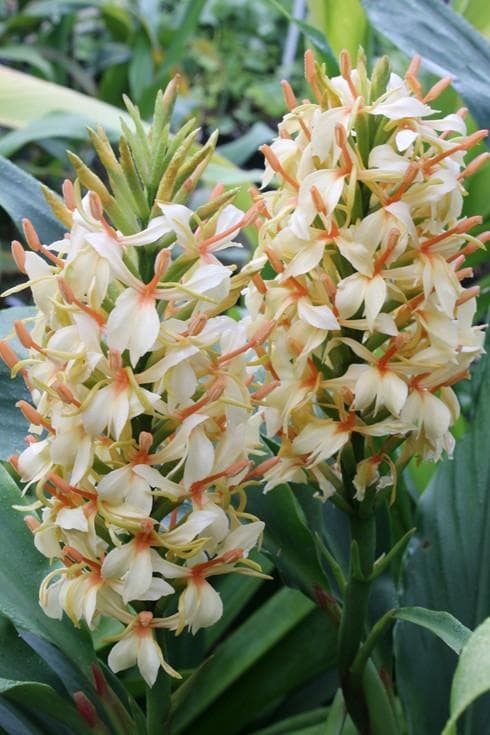Yellow Roscoea Roscoea humeana f. lutea

ABOUT
Roscoea humeana f. lutea, commonly known as the yellow Himalayan ginger, is a perennial herb that boasts an eye-catching appearance. The plant displays a clump of narrow, lance-shaped, green leaves that create an attractive backdrop for its flowers. Emerging on tall stems above the foliage, the flowers are of particular interest, with their unique shape and coloration. Each flower features a prominent spade-like hood, reminiscent of an exotic orchid, and is characterized by a lovely, soft yellow hue that adds a hint of brightness to any garden setting. These yellow flowers are often marked with subtle purple or violet tints, which further enhance the visual appeal of the plant. The blooming period of the yellow Himalayan ginger is during the summer months, presenting a charming display when many other plants might be past their peak. The plant has a clumping habit, with the leaves and flowering stems arising directly from a thick, underground stem. The leaves vary in shape but typically have a tapered look, contributing to the overall elegance of the plant. It is the combination of the graceful foliage and the delicate yellow blossoms that makes the yellow Himalayan ginger a coveted plant for garden enthusiasts looking for a touch of the Himalayas in their flower beds or borders.
About this plant
 Names
NamesFamily
Zingiberaceae
Synonyms
Yellow Roscoea
Common names
Roscoea humeana f. lutea.
 Toxicity
ToxicityTo humans
Roscoea does not have any widespread recognition of toxicity to humans. As with any plant, individual allergic reactions or sensitivities could occur, but these would be specific to the individual and not a general trait of the species. Therefore, there are no characteristic symptoms of poisoning known for Roscoea since it is not generally considered a poisonous plant. Always exercise caution and consult with a professional if you are considering ingesting any part of an unknown plant.
To pets
Likewise, there is no reported toxicity of Roscoea to pets such as dogs and cats. It is not known to be a poisonous plant, and there are no specific symptoms of poisoning associated with its ingestion by pets. However, it is always advisable to prevent pets from eating plants as individual animals might have sensitivities or allergies, and some plants may also cause gastrointestinal upset if not part of their usual diet.
 Characteristics
CharacteristicsLife cycle
Perennials
Foliage type
Deciduous
Color of leaves
Green
Flower color
Yellow
Height
1-2 feet (30-60 cm)
Spread
0.5-1 feet (15-30 cm)
Plant type
Herb
Hardiness zones
6
Native area
China
Benefits
 General Benefits
General Benefits- Ornamental Value: Roscoea humeana f. lutea, commonly known as Yellow Himalayan Ginger, adds visual interest to gardens with its bright yellow flowers and lush green foliage.
- Ease of Cultivation: This plant is relatively easy to grow with the right conditions, requiring minimal care, which makes it suitable for gardeners of various skill levels.
- Pollinator Attraction: Yellow Himalayan Ginger attracts beneficial pollinators such as bees and butterflies, which are essential for the pollination of many plants.
- Habitat Enrichment: By growing Yellow Himalayan Ginger, gardeners can contribute to enriching the habitat for wildlife, offering food and shelter to various species.
- Companion Planting: This plant can be used in companion planting to enhance the overall health and visual appeal of a garden.
- Seasonal Interest: With a bloom time in late spring to summer, it helps to provide visual interest in the garden throughout the growing season.
- Biodiversity Support: Adding native plants like Yellow Himalayan Ginger to the landscape supports local ecosystems and biodiversity.
 Medical Properties
Medical PropertiesThis plant is not used for medical purposes.
 Air-purifying Qualities
Air-purifying QualitiesThis plant is not specifically known for air purifying qualities.
 Other Uses
Other Uses- Roscoea humeana f. lutea, commonly known as Roscoea, can be used in landscape gardening to create attractive borders due to its vibrant yellow flowers and lush foliage.
- The root of the Roscoea plants is sometimes used in cooking, particularly in Himalayan regions, to add flavor to dishes, although Roscoea humeana f. lutea is specifically not documented for this use.
- Roscoea's unique flower shape makes it a desirable plant for ornamental purposes in rock gardens or as part of a floral arrangement in themed garden displays.
- The plant can serve as a biodiversity enhancer in domestic gardens by attracting pollinators such as bees and butterflies.
- Roscoea is used in educational gardens and botanical collections to illustrate the variety within the Zingiberaceae family and to educate about mountain flora.
- Photographers and artists may utilize Roscoea humeana f. lutea as a subject for their work, capturing its striking color and form.
- This plant species can be used in container gardening, adding a touch of exotic beauty to balconies and patios.
- In traditional Himalayan culture, parts of the Roscoea plant might be incorporated into local customs and rituals, although specifics for Roscoea humeana f. lutea are not well-documented.
- Because of its hardiness, Roscoea can be used in educational projects to demonstrate plant survival in various climatic conditions.
- Dried Roscoea flowers could potentially be used for craft purposes, such as in the creation of eco-friendly jewelry or decorations, although such uses are more common in other flowers.
Interesting Facts
 Feng Shui
Feng ShuiThe Roscoea is not used in Feng Shui practice.
 Zodiac Sign Compitability
Zodiac Sign CompitabilityThe Roscoea is not used in astrology practice.
 Plant Symbolism
Plant Symbolism- Rarity: Roscoea humeana f. lutea is a lesser-known plant, and it can symbolize something rare or unique.
- Exotic Beauty: Belonging to the ginger family, this perennial is admired for its exotic and attractive flowers, representing beauty that stands out.
- Adaptability: Since this plant is known to grow in various conditions in the wild, it may symbolize the ability to adapt and thrive in different environments.
- Simplicity: Despite its striking appearance, the simple lifestyle of the Roscoea humeana in natural settings can be a reminder of the importance of living a modest and unpretentious life.
 Water
WaterDwarf ginger appreciates consistent moisture during its growing season, usually spring and summer. Water the plant when the top inch of soil feels dry, which may be once or twice a week, depending on temperature and humidity. Use room temperature water and gently pour it around the base of the plant, avoiding the foliage, providing enough water so that it drains out of the bottom of the pot—this might be approximately a quarter to half a gallon every week for a medium-sized pot. Reduce watering in the dormant winter months, letting the soil dry out more between waterings.
 Light
LightDwarf ginger thrives in partial shade conditions, where it can receive bright, indirect sunlight. It is best placed in a spot where it is protected from the harsh midday sun, which can cause leaf scorch. An east or north-facing window would be an ideal location inside the home, providing the gentle morning or late afternoon light.
 Temperature
TemperatureDwarf ginger prefers moderate temperatures and does well in a range between 60 to 75 degrees Fahrenheit. Avoid exposing the plant to temperatures below 50 degrees Fahrenheit, as it can damage the plant. They are not frost-tolerant, so if grown outside they should be moved indoors before the first frost hits.
 Pruning
PruningPruning dwarf ginger is mostly done to remove faded flowers or dead foliage to maintain its aesthetic appeal and encourage healthier growth. The best time for pruning is in the dormant winter period when the plant's growth slows down. Pruning can be performed once a year or as needed when you notice dead or dying leaves.
 Cleaning
CleaningAs needed
 Soil
SoilHimalayan Cucumber needs well-draining soil with a mix of compost, perlite or sand, and loam for adequate nutrient content and drainage. A slightly acidic to neutral pH of 6.0 to 7.0 is optimal for its growth.
 Repotting
RepottingHimalayan Cucumber should be repotted every two to three years to refresh the soil and accommodate its growth, preferably in the spring just as the growing season begins.
 Humidity & Misting
Humidity & MistingHimalayan Cucumber thrives best in moderate to high humidity conditions, ideally around 60 to 80%, to mirror its native mountainous habitat.
 Suitable locations
Suitable locationsIndoor
Place in indirect light, plant in well-draining soil, and maintain humidity.
Outdoor
Grow in partial shade, use moist, fertile soil, shield from harsh sun.
Hardiness zone
6-9 USDA
 Life cycle
Life cycleRoscoea humeana f. lutea, commonly known as the Yellow Himalayan Ginger, begins its life as a rhizome, a type of underground stem that can produce new shoots. In spring, new shoots emerge from the rhizome, developing into long, lance-shaped leaves. Throughout the summer, the plant produces its distinct yellow flowers, which are attractive to pollinators and crucial for the plant's sexual reproduction phase. After pollination, the flowers give way to seed pods, which mature and eventually release seeds, spreading to form new plants. Throughout the colder months, the aboveground foliage of the Yellow Himalayan Ginger dies back, while the rhizome remains dormant underground until the next growing season. This cycle allows the plant to survive in its mountainous habitats by undergoing a period of dormancy during harsh weather conditions.
 Propogation
PropogationPropogation time
Spring to summer
Roscoea humeana f. lutea, commonly known as the Yellow Chinese ginger, is typically propagated by dividing its rhizomes. The best time to propagate this plant is in the late winter or early spring just before the new growth starts. During this period, the rhizomes are dug up and carefully split into sections, each with at least one growth bud. It's important to handle the rhizomes gently to prevent damage. After division, these sections are replanted in well-draining soil at a depth of about 2 inches (approximately 5 centimeters) and spaced about 6 to 8 inches (15 to 20 centimeters) apart to allow ample room for growth. The plant should be watered thoroughly after planting to help establish it in its new location.
